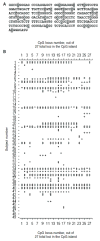DNA/RNA markers for colorectal cancer risk in preserved stool specimens: a pilot study
- PMID: 20210241
- PMCID: PMC4932904
- DOI: 10.1177/030089160909500619
DNA/RNA markers for colorectal cancer risk in preserved stool specimens: a pilot study
Abstract
Aims and background: Exfoliated cells in human stool offer excellent opportunities to non-invasively detect molecular markers associated with colorectal tumorigenesis, and to evaluate the effects of exposures to exogenous and endogenous carcinogenic or chemopreventive substances. This pilot study investigated the feasibility of determining DNA methylation and RNA expression simultaneously in stool specimens treated with a single type of nucleic acid preservatives.
Methods: Stool specimens from 56 volunteers that were preserved up to a week with RNA later were used in this study. Bisulfite sequencing was used to determine methylation at 27 CpG loci on the estrogen receptor 1 (ESR1) promoter. Taqman assay was used for quantitative reverse transcription polymerase chain reactions to measure cyclooxygenase 2 (COX2) and epidermal growth factor receptor (EGFR) mRNA expression. Subjects' basic demographic and other selected risk factors for colorectal cancer were captured through questionnaires and correlated with the levels of these markers.
Results: Less than 10% of the samples failed in individual assays. Overall, 24.0% of the CpG loci on the ESR1 promoter were methylated. COX2 expression and alcohol use were positively correlated; an inverse association was present between EGFR expression and cigarette smoking; and subjects using anti-diabetic medication had higher ESR1 methylation. In addition, higher EGFR expression levels were marginally associated with history of polyps and family history of colorectal cancer.
Conclusions: The present study demonstrates that simultaneous analyses for DNA and RNA markers are feasible in stool samples treated with a single type of nucleotide preservatives. Among several associations observed, the association between EGFR expression and polyps deserves further investigation as a potential target for colorectal cancer screening. Larger studies are warranted to confirm some of our observations.
Figures

Similar articles
-
Quantitative profiling of CpG island methylation in human stool for colorectal cancer detection.Int J Colorectal Dis. 2013 Jan;28(1):35-42. doi: 10.1007/s00384-012-1532-5. Epub 2012 Jul 13. Int J Colorectal Dis. 2013. PMID: 22791128 Clinical Trial.
-
Feasibility of quantifying SDC2 methylation in stool DNA for early detection of colorectal cancer.Clin Epigenetics. 2017 Dec 4;9:126. doi: 10.1186/s13148-017-0426-3. eCollection 2017. Clin Epigenetics. 2017. PMID: 29225717 Free PMC article.
-
TERT Promoter Hypermethylation in Gastrointestinal Cancer: A Potential Stool Biomarker.Oncologist. 2017 Oct;22(10):1178-1188. doi: 10.1634/theoncologist.2017-0064. Epub 2017 Jul 28. Oncologist. 2017. PMID: 28754720 Free PMC article.
-
Stool DNA methylation assays in colorectal cancer screening.World J Gastroenterol. 2015 Sep 21;21(35):10057-61. doi: 10.3748/wjg.v21.i35.10057. World J Gastroenterol. 2015. PMID: 26401070 Free PMC article. Review.
-
DNA methylation markers in colorectal cancer.Cancer Metastasis Rev. 2010 Mar;29(1):181-206. doi: 10.1007/s10555-010-9207-6. Cancer Metastasis Rev. 2010. PMID: 20135198 Review.
Cited by
-
Characterizing m6A modification factors and their interactions in colorectal cancer: implications for tumor subtypes and clinical outcomes.Discov Oncol. 2024 Sep 18;15(1):457. doi: 10.1007/s12672-024-01298-1. Discov Oncol. 2024. PMID: 39292326 Free PMC article.
-
Methylated eyes absent 4 (EYA4) gene promotor in non-neoplastic mucosa of ulcerative colitis patients with colorectal cancer: evidence for a field effect.Inflamm Bowel Dis. 2013 Sep;19(10):2079-83. doi: 10.1097/MIB.0b013e31829b3f4d. Inflamm Bowel Dis. 2013. PMID: 23867875 Free PMC article.
-
Discovery of genes from feces correlated with colorectal cancer progression.Oncol Lett. 2016 Nov;12(5):3378-3384. doi: 10.3892/ol.2016.5069. Epub 2016 Aug 31. Oncol Lett. 2016. PMID: 27900008 Free PMC article.
-
Presence of Salmonella AvrA in colorectal tumor and its precursor lesions in mouse intestine and human specimens.Oncotarget. 2017 Jul 6;8(33):55104-55115. doi: 10.18632/oncotarget.19052. eCollection 2017 Aug 15. Oncotarget. 2017. PMID: 28903406 Free PMC article.
References
-
- Iyengar V, Albaugh GP, Lohani A, Nair PP. Human stools as a source of viable colonic epithelial cells. FASEB J. 1991;5:2856–2859. - PubMed
-
- Desilets DJ, Davis KE, Nair PP, Salata KF, Maydonovitch CL, Howard RS, Kikendall JW, Wong RK. Lectin binding to human colonocytes is predictive of colonic neoplasia. Am J Gastroenterol. 1999;94:744–750. - PubMed
-
- Osborn NK, Ahlquist DA. Stool screening for colorectal cancer: Molecular approaches. Gastroenterology. 2005;128:192–206. - PubMed
-
- Davis CD. Use of exfoliated cell from target tissues to predict responses to bioactive food components. J Nutr. 2003;133:1769–1772. - PubMed
Publication types
MeSH terms
Substances
Grants and funding
LinkOut - more resources
Full Text Sources
Medical
Research Materials
Miscellaneous

